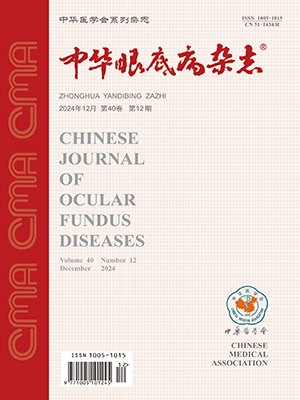| 1. |
Deshmane SL, Kremlev S, Amini S, et al. Monocyte chemoattractant protein-1 (MCP-1):an overview[J]. J Interferon Cytokine Res, 2009, 29:313-326.
|
| 2. |
Marshall J, Bird AC. A comparative histopathological study of argon and krypton laser irradiations of the human retina[J]. Br J Ophthalmol, 1979, 63:657-668.
|
| 3. |
Lambert V, Lecomte J, Hansen S, et al. Laser-induced choroidal neovascularization model to study age-related macular degeneration in mice[J]. Nat Protoc, 2013, 8:2197-2211.
|
| 4. |
Ng TF, Turpie B, Masli S. Thrombospondin-1-mediated regulation of microglia activation after retinal injury[J]. Invest Ophthalmol Vis Sci, 2009, 50:5472-5478.
|
| 5. |
蒋元丰,张晓敏,张琰,等. 尾静脉注射骨髓间充质干细胞对小鼠视网膜激光损伤后细胞凋亡的影响[J]. 中华眼底病杂志, 2013, 29:67-71.
|
| 6. |
Belokopytov M, Shulman S, Dubinsky G, et al. Intravitreal saline injection ameliorates laser-induced retinal damage in rats[J]. Retina, 2012, 32:1165-1170.
|
| 7. |
Ben-Shlomo G, Belokopytov M, Rosner M, et al. Functional deficits resulting from laser-induced damage in the rat retina[J]. Lasers Surg Med, 2006, 38:689-694.
|
| 8. |
Suzuki M, Ozawa Y, Kubota S, et al. Neuroprotective response after photodynamic therapy:role of vascular endothelial growth factor[J]. J Neuroinflammation, 2011, 8:176.
|
| 9. |
Kasaoka M, Ma J, Lashkari K. c-Met modulates RPE migratory response to laser-induced retinal injury. PLoS One, 2012, 7:40771.[2012-07-13]http://www.plosone.org/article/info:doi/10.1371/journal.pone.0040771?imageURI=info:doi/10.1371/journal.pone.0040771.g002.
|
| 10. |
Liang KJ, Lee JE, Wang YD, et al. Regulation of dynamic behavior of retinal microglia by CX3CR1 signaling[J]. Invest Ophthalmol Vis Sci, 2009, 50:4444-4451.
|
| 11. |
Cushing SD, Berliner JA, Valente AJ, et al. Minimally modified low density lipoprotein induces monocyte chemotactic protein 1 in human endothelial cells and smooth muscle cells[J]. Proc Natl Acad Sci USA, 1990, 87:5134-5138.
|
| 12. |
van Coillie E, van Damme J, Opdenakker G. The MCP/eotaxin subfamily of CC chemokines[J]. Cytokine Growth Factor Rev, 1999, 10:61-86.
|
| 13. |
Chen H, Liu B, Lukas TJ, et al. The aged retinal pigment epithelium/choroid:a potential substratum for the pathogenesis of age-related macular degeneration. PLoS One, 2008, 3:2339.[2008-06-04]http://www.plosone.org/article/info%3Adoi%2F10.1371%2Fjournal.pone.0002339.
|
| 14. |
Yamada K, Sakurai E, Itaya M, et al. Inhibition of laser-induced choroidal neovascularization by atorvastatin by downregulation of monocyte chemotactic protein-1 synthesis in mice[J]. Invest Ophthalmol Vis Sci, 2007, 48:1839-1843.
|
| 15. |
Tsutsumi C, Sonoda KH, Egashira K, et al. The critical role of ocular-infiltrating macrophages in the development of choroidal neovascularization[J]. J Leukoc Biol, 2003, 74:25-32.
|
| 16. |
Krady JK, Basu A, Allen CM, et al. Minocycline reduces proinflammatory cytokine expression, microglial activation, and caspase-3 activation in a rodent model of diabetic retinopathy[J]. Diabetes, 2005, 54:1559-1565.
|
| 17. |
Dong N, Li X, Xiao L, et al. Upregulation of retinal neuronal MCP-1 in the rodent model of diabetic retinopathy and its function in vitro[J]. Invest Ophthalmol Vis Sci, 2012, 53:7567-7575.
|




